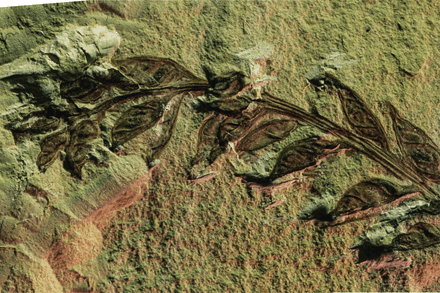The Origins of Flowering Plants and Pollinators
1. Casper J. van der Kooi1,
2. Jeff Ollerton2
See all authors and affiliations
Science 19 Jun 2020:
Vol. 368, Issue 6497, pp. 1306-1308
DOI: 10.1126/science.aay3662
The aquatic angiosperm Archaefructus liaoningensis is one of the earliest fossil angiosperms to have been identified so far.
Photo: Jonathan Blair/National Geographic Image Collection
For more than a century there has been a fascination with the surprisingly rapid rise and early diversity of flowering plants (angiosperms). Darwin described the seemingly explosive diversification of angiosperms as an “abominable mystery,” and debates continue about the origin and processes driving angiosperm speciation. Dating the origin of angiosperms was traditionally the prerogative of paleobotanists who read the fossil record of plants, but with DNA sequencing becoming increasingly sophisticated, molecular dating methods have come to the table. Many angiosperm fossils can be dated to the Early Cretaceous (∼135 million years ago), which has led paleobotanists to reason that they originated during that era. It is now increasingly recognized that angiosperms are probably older than the oldest fossils, but how much older remains controversial. When angiosperms originated is key to understanding the origin and evolution of pollinators, particularly insects such as bees, butterflies, moths, and flies.
Both paleontological records and molecular analyses have their strengths and weaknesses. The strength of fossils is that they can provide information on past form, function, and clade richness, and indirectly provide information on speciation and extinction. Fossils are particularly useful when they harbor intermediate structures or combinations of characters that no longer exist, which can provide insightful examples that help to reconstruct the course of evolutionary events. However, the interpretation of fossils can be subjective and controversial, because important features of these plants may not be preserved and often must be inferred from two-dimensional compressed remains.
One of the hallmarks of angiosperms is their relationship with animal pollinators, especially insects. As with plants, the diversification of insects is a field with many uncertainties. The origin of several important orders of flower-visiting insects (e.g., Coleoptera, Diptera, Hymenoptera, and Lepidoptera) lies in the Permian or Triassic (300 to 200 million years ago) with marked periods of diversification in the Cretaceous, which is frequently mentioned to coincide with the main angiosperm radiation (7). However, the timing of the origin of flower-visiting insects is debated. For example, for Lepidoptera (butterflies and moths), a Late Triassic radiation has been suggested on the basis of fossil evidence (8), but a recent study using transcriptomes covering nearly all Lepidoptera superfamilies dated the origin even further back, during the Carboniferous (∼300 million years ago) (9). Although butterfly diversification may be triggered more by host plant chemistry than by floral diversity—which need not be correlated—given the importance of butterflies and moths for angiosperm reproduction, their diversification is important in understanding plant-pollinator interactions.
To read the complete article please go to the link below.
https://science.sciencemag.org/content/368/6497/1306
________________________________________________________________________________










